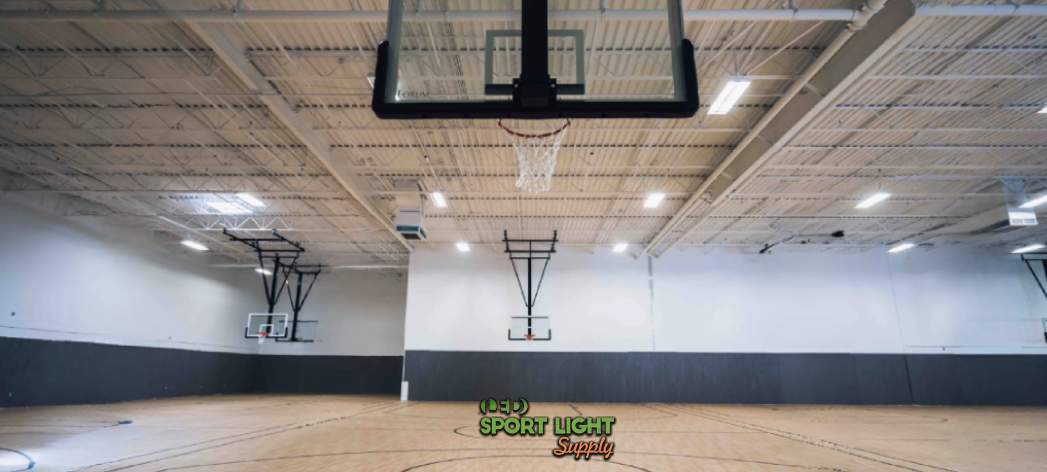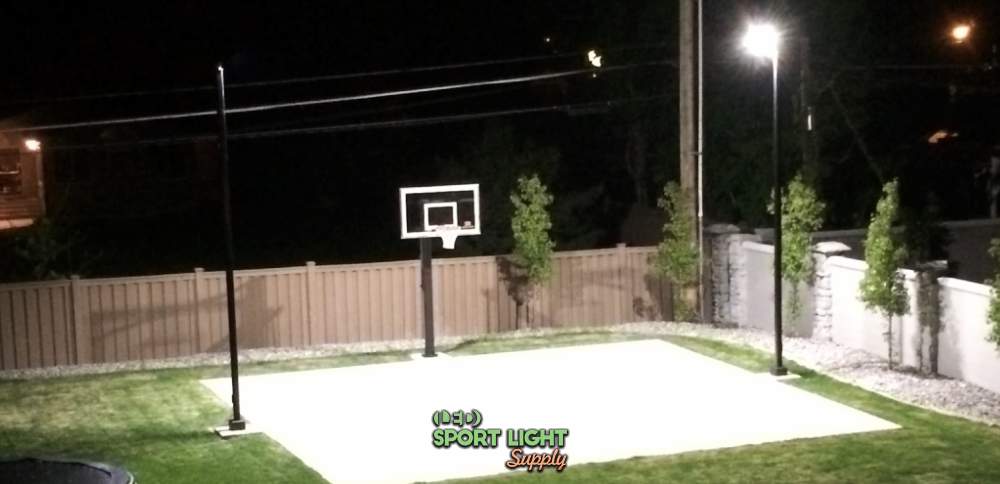Basketball courts, whether indoor or outdoor, are more than just spaces for games—they are arenas where passion, skill, and athleticism converge under the glow of expertly designed lighting. The quality of lighting can significantly impact gameplay, safety, and overall ambiance, making it a crucial aspect of court design.
Table of Contents
ToggleIndoor basketball courts require precise lighting to ensure optimal visibility and performance. The recommended lux level for indoor basketball courts varies based on the level of play. For recreational play, a minimum of 300 lux is typically sufficient. However, for competitive and professional games, lighting levels should be between 800 to 1,200 lux. This higher lux level helps in reducing shadows and ensuring that players can see the ball and court markings clearly, enhancing the quality of the game.
Uniformity in lighting is another critical aspect. It is essential that the light is evenly distributed across the court to prevent any dark spots or excessive glare. LED fixtures are designed to provide uniform illumination, which is vital for maintaining the integrity of the game and ensuring that players have consistent visibility from all areas of the court.
Proper fixture placement is key to achieving the desired lighting effects. In indoor courts, lights are typically mounted on the ceiling. The height of the light fixtures usually ranges from 20 to 30 feet, depending on the size of the court and the specific lighting needs. For larger courts or arenas, the installation might involve high-bay LED fixtures that can cover a wider area and provide the necessary brightness.

The arrangement of fixtures should be strategically planned to avoid shadows and ensure even coverage. A common approach is to use a grid layout, where lights are evenly spaced along the perimeter of the court and directed downward. This arrangement helps in achieving uniform illumination and minimizes the risk of glare affecting players and spectators.
Outdoor basketball courts require robust lighting solutions that can withstand environmental conditions while providing adequate brightness. The lux requirements for outdoor courts are similar to those for indoor courts, with recreational play needing around 300 lux and competitive play requiring up to 1,200 lux.
In addition to brightness, coverage is crucial for outdoor courts. The lighting system must be designed to illuminate the entire court effectively, including the surrounding areas where players and spectators might be. This requires careful consideration of the number of lights and their placement to ensure that no areas are left in darkness.

For outdoor basketball courts, the height of the light poles is a critical factor in achieving the desired illumination. Typically, the poles are installed at heights ranging from 20 to 30 feet, similar to indoor setups. However, the height might vary based on the size of the court and the specific lighting requirements.
Fixture placement for outdoor courts often involves mounting lights on poles situated around the perimeter of the court. This arrangement helps in providing consistent lighting while minimizing shadows. Additionally, the fixtures should be angled correctly to avoid direct glare, which can be distracting for players and spectators.
Modern basketball courts often incorporate advanced lighting controls that allow for dimming and adjustment of light levels. This feature is particularly useful for adjusting the lighting based on the type of event or time of day. For instance, during practice sessions or recreational games, the lights can be dimmed to save energy, while they can be brightened for competitive matches or events.
Control systems also enable automated adjustments based on real-time conditions, such as weather changes for outdoor courts. This adaptability ensures that the lighting remains effective and consistent, regardless of external factors.
As the demand for energy-efficient solutions grows, basketball court lighting systems are increasingly focusing on sustainability. LED technology, known for its low energy consumption and long lifespan, plays a significant role in this shift. By reducing the amount of energy used and extending the time between replacements, LED lighting contributes to lower carbon emissions and a smaller environmental footprint.
Moreover, integrating solar panels with LED lighting systems can further enhance sustainability. Solar-powered lights harness energy from the sun, providing an eco-friendly alternative to traditional power sources. This approach not only reduces energy costs but also aligns with green building practices.
One of the significant advantages of LED lighting is its minimal maintenance requirements. LEDs are designed to last longer than traditional bulbs, which means fewer replacements and lower maintenance costs. This durability is particularly beneficial for high-usage environments like basketball courts, where frequent maintenance can be disruptive and costly.
To maximize the lifespan of LED fixtures, it is essential to ensure proper installation and use. Regular inspections and cleaning of the fixtures can help maintain optimal performance and prevent issues such as dirt accumulation or damage. Additionally, using high-quality LED fixtures designed for sports facilities ensures that they can withstand the demanding conditions of a basketball court.
Inappropriate lighting can severely impact both gameplay and safety on basketball courts. Insufficient or uneven lighting creates shadows and glare, making it difficult for players to see the ball and court markings clearly. This not only hampers performance but also increases the risk of accidents, such as collisions and missed shots. For indoor courts, inadequate lighting can affect the accuracy of shots and overall game quality, while for outdoor courts, poor lighting may lead to safety concerns for players and spectators alike.
Improper lighting can also cause significant eye strain and fatigue. Glare from overly bright or poorly directed lights can force players to squint and strain their eyes, leading to discomfort and decreased focus. Over time, this can contribute to visual fatigue, affecting players’ performance and enjoyment of the game. For both indoor and outdoor courts, it is crucial to ensure that lighting is uniform and appropriately designed to minimize glare and reduce eye strain.
Lighting plays a crucial role in creating an engaging atmosphere for spectators. Inadequate or poorly designed lighting can lead to a lackluster experience for fans, affecting their enjoyment and perception of the game. For outdoor courts, this can be particularly problematic during evening or night games, where insufficient lighting can diminish the overall ambiance and visibility for the audience. Effective lighting design not only enhances the game experience but also contributes to a vibrant and enjoyable atmosphere for everyone involved.
For indoor basketball courts, achieving the right lux levels and uniformity is essential for high-quality gameplay. A minimum of 300 lux is suitable for recreational play, while competitive games require 800 to 1,200 lux to ensure clear visibility. Uniformity is key to preventing shadows and glare, so LED fixtures should be strategically placed to provide even illumination across the entire court. A grid layout, with fixtures mounted on the ceiling, helps in distributing light evenly and reducing dark spots.
The placement and height of fixtures are critical in indoor lighting design. Fixtures should be mounted 20 to 30 feet above the court to cover the playing area effectively. The lighting layout should ensure that fixtures are evenly spaced around the perimeter and directed downward to provide uniform coverage. Avoid placing fixtures too close to the court to prevent glare and shadows. Using high-bay LED fixtures can also help in achieving the desired brightness and coverage for larger courts.
Incorporating advanced control systems allows for greater flexibility in lighting management. Dimming capabilities and automated adjustments based on game type or time of day can enhance the functionality of the lighting system. This adaptability helps in optimizing light levels and energy efficiency while creating the right ambiance for various events.
For outdoor basketball courts, the lighting system must provide sufficient brightness and coverage to ensure safety and performance. The lux levels should match those required for indoor courts, with 300 lux for recreational play and up to 1,200 lux for competitive games. Additionally, the lighting system should cover the entire court, including surrounding areas, to enhance visibility and safety.
The height of light poles for outdoor courts typically ranges from 20 to 30 feet. Proper pole height ensures that the light covers the court effectively without causing excessive glare. Fixtures should be mounted on poles situated around the perimeter of the court, angled to reduce direct glare and provide uniform illumination. This setup helps in minimizing shadows and ensuring consistent lighting across the playing area.
Outdoor lighting fixtures must be designed to withstand environmental conditions such as rain, wind, and temperature fluctuations. Choosing fixtures with weather-resistant ratings and durable materials ensures that they perform reliably and have a long lifespan. This durability is essential for maintaining effective lighting and reducing maintenance needs.
The quality of lighting on basketball courts—whether indoor or outdoor—significantly impacts gameplay, safety, and overall experience. Proper illumination ensures optimal visibility and performance by achieving the right lux levels, maintaining uniformity, and employing strategic fixture placement. Advanced control systems and LED technology further enhance the adaptability and efficiency of the lighting setup, contributing to energy savings and reduced maintenance. By addressing these aspects, we can create well-lit courts that not only elevate the game but also provide a safe and enjoyable environment for players and spectators alike.
Drop us a line to receive a free lighting design